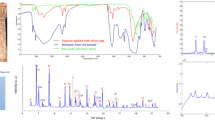Summary
An Egyptian wooden sarcophagus and a cartonnage (664–525 B.C.) were subjected to pyrolysis-gas chromatography-mass spectrometry (PY-GC-MS) and Fourier-transform infrared spectroscopy (FT-IR) in order to characterize pigments and organic binding media. The aim of these investigations is to acquire a better knowledge of the painting technique used in ancient Egypt. Results showed that PY-GC-MS offered a rapid tool to discriminate between wax-based- and animal protein-based binders and to recognize the use of mixtures of the two products. FT-IR corroborated the pyrolysis findings, but sometimes provided less unequivocal results than PY-GC-MS. As an additional benefit, PY-GC-MS allowed the identification of a yellow pigment as the arsenic sulphide orpiment by means of the volatile As4 among the pyrolysis fragments.
Similar content being viewed by others
References
“La Collezione Egiziana del Museo Civico Archeologico di Bologna”, Leonardo Arte, Milano, 1994, p. 93.
G. Chiavari, P. Bocchini, G. C. Galletti, Science and Technology for Cultural Heritage1, 153 (1992).
G. Chiavari, G. C. Galletti, G. Lanterna, G. Mazzeo, J. Anal. Appl. Pyrolysis24, 242 (1993).
G. C. Galletti, R. Mazzeo, Rapid Comm. Mass Spectrom.7, 646 (1993).
Catalogo della Mostra “Il Senso dell'Arte nell'Antico Egitto”, Electa, Milano, 1990. No. 159, p. 211.
E. D'Amicone, in: “Dal Museo al Museo-Passato e Futuro del Museo Egizio di Torino”, A. M. Donadoni Roveri ed., Umberto Allemandi a. Co., Torino, 1989, p. 75.
A. Lucas, Ancient Egyptian materials and industries, 4th edition revised and enlarged by J. R. Harris, Edward Arnold Publishers Ltd., London, 1962.
A. M. Shedrinsky, R. E. Stone, N. S. Baer, J. Anal. Appl. Pyrolysis20, 229 (1991).
G. Chiavari, G. C. Galletti, J. Anal. Appl. Pyrolysis24, 123 (1992).
M. Janai, P. S. Rudman, A. Mandelbaum, J. Non-Cryst. Solids27, 67 (1978).
M. Matteini, A. Moles, La Chimica nel Restauro — I Materiali dell'Arte Pittorica, 3rd Edition, Nardini, Firenze 1993.
J. F. J. Todd, Mass Spectr. Rev.10, 3 (1991).
Author information
Authors and Affiliations
Rights and permissions
About this article
Cite this article
Chiavari, G., Fabbri, D., Galletti, G.C. et al. Use of analytical pyrolysis to characterize Egyptian painting layers. Chromatographia 40, 594–600 (1995). https://doi.org/10.1007/BF02290274
Received:
Accepted:
Issue Date:
DOI: https://doi.org/10.1007/BF02290274




